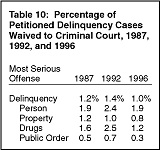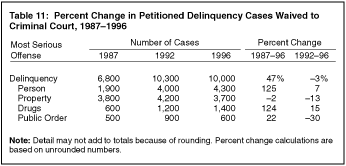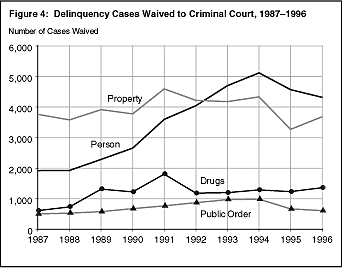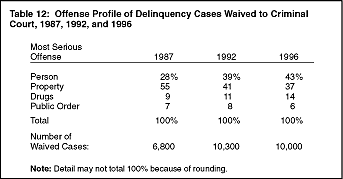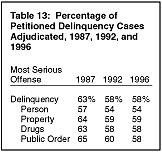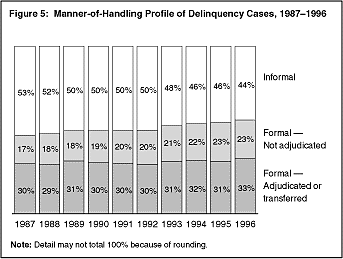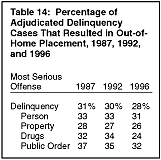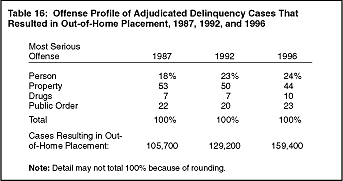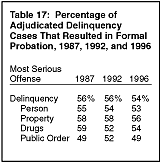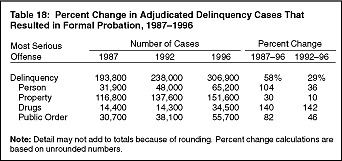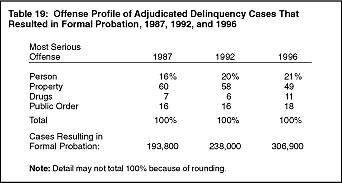|
Waiver
One of the first decisions made at intake is determining whether a case should be processed in the criminal (adult) justice system rather than in the juvenile court. The mechanisms used to transfer responsibility for a case to the criminal court vary by State. Most States have more than one mechanism for transferring cases to criminal court. In some States, prosecutors may have the authority to file certain juvenile cases directly in criminal court. In an increasing number of States, cases that meet certain age and offense criteria are excluded by statute from juvenile court jurisdiction and are thus filed directly in criminal court. In most States, there are also statutory provisions for judicial waiver, whereby a juvenile court judge may waive juvenile court jurisdiction in certain juvenile cases, thus authorizing a transfer to criminal court. In most instances, when a waiver request is denied, the case is then scheduled for an adjudicatory hearing in juvenile court. The data described in this Report represent only cases that were transferred to criminal court by judicial waiver.
Judicial waivers to criminal court represented 1.0% of all petitioned delinquency cases in 1996 (table 10). As in 1987, the cases most likely to be judicially waived in 1996 were those involving person offenses. In 1991, drug offense cases were substantially more likely to be waived than person
offense cases (4.1% versus 2.4%). However, in 1996, cases involving person offenses were once again more likely to be judicially waived than those involving drug offenses (1.9% versus 1.2%) were. In 1996, 0.8% of cases involving property offenses were waived to criminal court, down from 1.2% in 1987.
The number of delinquency cases judicially waived to criminal court grew 73% between 1987 and 1994 and then dropped 15% between 1994 and 1996. The net result was that the number of cases judicially waived was 47% greater in 1996 than in 1987 (table 11). The greatest relative change between 1987 and 1996 in waived cases was for person and drug offense cases (125% and 124%, respectively). There was a 22% increase in waived public order offense cases and a 2% decline in waived property offense cases.
The pattern of change in the number of waived cases between 1987 and 1996 varied across offense categories (figure 4). For drug cases, the number of waived cases increased substantially from 1987 through 1991 (198%) and then declined substantially between 1991 and 1992 (35%) before rising 15% between 1992 and 1996. The net result was that the number of judicially waived drug offense cases increased 124% between 1987 and 1996. The number of waived person offense cases increased substantially between 1987 and 1994 (167%) and then decreased 16% to the 1996 level. Waived property cases increased 15% between 1987 and 1994, dropped 24% in 1995, and increased 13% in 1996. Overall, between 1987 and 1996, the number of property cases judicially waived decreased 2%. For public order cases, the number of waived cases increased between 1987 and 1994 (97%) and then declined through 1996 (15%).
As a result, the offense profile of cases judicially waived to criminal court changed considerably between 1987 and 1996. The proportion of all waived delinquency cases that involved a property offense as the most serious charge declined from 55% in 1987 to 37% in 1996 (table 12). In 1996, the largest group of waived cases involved person offenses. The proportion of person offenses among judicially waived cases grew from 28% to 43% between 1987 and 1996. Drug offense cases increased from 9% of all waivers in 1987 to a high of 17% in 1991, and then declined to 11% in 1992. In 1996, drug offense cases represented 14% of the cases judicially waived to criminal court. The proportion of public order cases among waived cases has held steady between 6% and 9%.
Adjudication
A youth may be adjudicated delinquent after admitting to the charges in a case or after the court finds sufficient evidence to judge the youth a delinquent. The court adjudicated juveniles delinquent in 58% of all formally processed delinquency cases in 1996 (table 13). The court adjudicated 54% of person offense cases, 59% of property offense cases, 58% of drug law violation cases, and 58% of public order offense cases.
The proportion of petitioned delinquency cases in which the juvenile was adjudicated delinquent decreased from 63% to 58% between 1987 and 1996. The proportion decreased from 57% to 54% for person offense cases, from 64% to 59% for property offense cases, from 63% to 58% for drug offense cases, and from 65% to 58% for public order offense cases.
Although adjudications declined as a percentage of formally handled delinquency cases between 1987 and 1996, when adjudications and transfers to criminal court are measured together as a proportion of all delinquency cases, the practices of juvenile courts are found to have changed very little during this period (figure 5). During the 10-year period, cases resulting in transfer or adjudication have accounted for about 3 in 10 delinquency cases. During the same period, however, the overall use of formal processing increased 10%.
Disposition
In dispositional hearings, juvenile court judges must determine the most appropriate sanction for delinquent youth, generally after reviewing reports from the probation department. The range of disposition options may include commitment to an institution or another residential facility; probation; or a variety of other dispositions, such as referral to an outside agency or treatment program, community service, restitution, or fines.
In more than half (54%) of all adjudicated delinquency cases in 1996, formal probation was the most severe sanction ordered by the court. More than one-quarter (28%) of adjudicated cases resulted in placement outside the home in a residential facility.6 In 13% of adjudicated delinquency cases, the court ordered the juvenile to pay restitution or a fine, to participate in some form of community service, or to enter a treatment or counseling program—dispositions with minimal continuing supervision by probation staff. In a relatively small number of cases (4%), the juvenile was adjudicated but was released with no further sanction or consequence.
In 41% of all petitioned delinquency cases in 1996, the youth was not subsequently adjudicated delinquent. The court dismissed most of these cases (60%), but 20% resulted in some form of informal probation, 18% in other voluntary dispositions, and 2% in voluntary out-of-home placements.
Out-of-Home Placement. The court ordered out-of-home placement in 159,400 (28%) of all adjudicated delinquency cases in 1996 (table 14). Juveniles charged with drug offenses were less likely to be placed outside the home than were those charged with person or public order offenses. Following adjudication, placement was ordered in 26% of property cases and 24% of drug cases, compared with 31% of person offense cases and 32% of public order offense cases. The relatively high rate of placement in public order offense cases may be related to the fact that this offense category includes escapes from institutions, weapons offenses, and probation and parole violations.
Although the likelihood of a delinquency case resulting in out-of-home placement declined between 1987 and 1996 for all four of the major offense categories, the number of adjudicated delinquency cases resulting in out-of-home placement increased 51% (table 15). During the 10-year period, placements increased more for drug offense (102%) and person offense (100%) cases than for property offense (25%) and public order offense (55%) cases.
In 1996, 44% of all adjudicated cases that resulted in out-of-home placement involved property offenses, 24% involved person offenses, 23% involved public order offenses, and 10% involved drug law violations (table 16). Between 1987 and 1996, the offense profile of the juveniles involved in out-of-home placement cases changed somewhat. The proportion of out-of-home placement cases that involved person and drug offenses increased, while the proportion involving property offenses declined.
Formal Probation. Formal probation was the most restrictive disposition used in 306,900 adjudicated delinquency cases in 1996—54% of all such cases handled by juvenile courts (table 17). Juvenile courts ordered formal probation in 56% of adjudicated cases involving property offenses, 54% involving drug law violations, 53% involving person offenses, and 49% involving public order offenses.
The likelihood of formal probation decreased slightly for adjudicated delinquency cases between 1987 and 1996. The use of probation decreased from 55% to 53% for person offense cases, from 58% to 56% for property offense cases, from 59% to 54% for drug law violations, and hovered around 50% for public order offense cases.
Although the proportion of adjudicated cases resulting in a disposition of formal probation declined between 1987 and 1996, the number of such cases increased 58% (table 18). The increase was 104% for person offenses, 30% for property offenses, 140% for drug law violations, and 82% for public order offenses.
Nearly half of the delinquency cases that resulted in formal probation in 1996 involved property offenses, 21% involved person offenses, 18% involved public order offenses, and 11% involved drug law violations (table 19). The offense characteristics of cases resulting in formal probation changed somewhat between 1987 and 1996, with an increase in the proportion of cases involving person or drug offenses and a decrease in the proportion involving property offenses.
|
